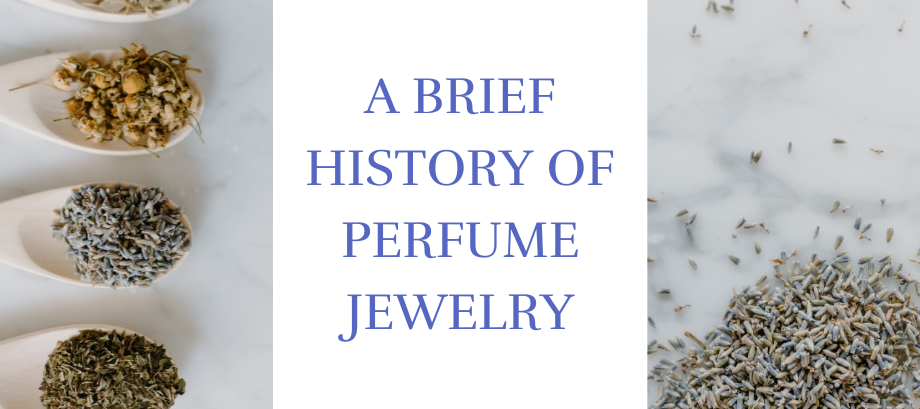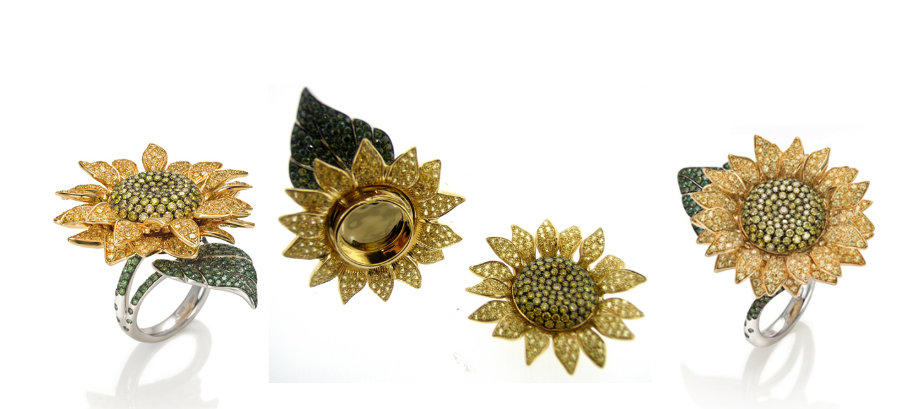A brief history of perfume jewelry

Once upon a time, intoxicating fragrances were worn as a form of aromatherapy, wrapped in the beauty of ornaments. Before research could provide an explanation for why certain scents have the potential to pacify, invigorate, and trigger profound thoughts, many believed that certain fragrances should be characteristically used as olfactory good luck charms.
Ancient Egyptian necklaces made of beads of skhab, an aromatic paste, are the earliest examples of aromatic jewelry. Supposedly, they hold their aroma for many years. Because the necklace is considered such a potent aphrodisiac, it is still worn today in various parts of the world and is subject to strict regulations. Only married women wear it, and only when they are with their husbands. The necklaces made of skhab beads from ancient Egypt are the first documented examples of scented jewelry.

Ancien Egyptian Art & Perfume Bottles (Photo: The Metropolitan Museum of Art, Public domain)
Fast forward to the 12th century, King Baldwin of Jerusalem gave Emperor Frederick Barbarossa a gift of "golden apples" laced with musk. The term translates from French as " apple of ambergris" or "pomme d'ambre."
Ambergris is a thick, waxy substance that forms in the entrails of sperm whales and is called "the treasure of the sea" or "floating gold". Found on the coasts of Japan, China and Greenland, ambergris stabilizes fragrances and imparts a musky essence to perfumes. It became the object of a new obsession.
The apple- or orange-shaped pomander made of silver or gold was designed to preserve and disperse perfume. A hinged lid opened the cages, which held several kinds of fragrances. Hazelnut-sized pomanders were often worn on bracelets, necklaces, and rings. Large pomanders were suspended from chains worn around the waist. Even when empty, the pomander was believed to be such an effective amulet that it could protect the wearer and anyone nearby from illness.
The idea of adorning the body with powerful fragrances and exquisite jewelry led to a union of fashion and perfume that peaked in the early 17th century. At that time, European kings wanted to have their perfume with them always and everywhere. Perfume jewelry designed by master craftsmen, therefore, enjoyed great popularity. Kings even had their own jewelers and perfumers to serve them on demand. Perfumes were made only in tiny, handmade batches, and only the wealthy could afford such luxury. Therefore, not only did most people not own more than a small amount of perfume, but it made sense to carry it with them and keep it safe. Perfume-infused rings, earrings, belts, and bracelets were considered indispensable by rich men, women, and young people who went all crazy about decorative, scented accessories.
People also wore perfume for protection, to distract themselves from the foul odors of others, and also as a barrier against diseases long believed to be transmitted by bad air. Perfume stored in jewelry rings and pendants could be held in front of the nose when unpleasant odors were present, forming a pungent wall. Perfumed jewelry was not only luxurious and functional but also esthetically pleasing. In the nineteenth century, necklaces made of precious metals were filled with solid perfumed balsams. During this period, numerous engraved and gemstone-decorated varieties were created. With a decorative perfumed jewelry element, wearability became possible, fragrances could be applied at any time, and it could provide comfort to bystanders.
Perfumed jewelry came in the form of earrings, lockets, bracelets, and rings, all designed with wearability in mind. Over time, these adaptable strategies for playing with intoxicating scents were replaced by liquid perfumes in handmade glass bottles.
Wearable perfume fully merged into the world of fashion by the 18th century. A little sponge would be covered in a fragrance made of alcohol or vinegar and kept in a vinaigrette, a portable smelling box. The smells, which were supposed to stimulate and repair, were harsh rather than sweet.

Vinaigrette box-The Metropolitan Museum of art
Women wore their vinaigrettes on their chatelaines throughout the late 18th century. The idea came from the keys that castle keepers wore on their belts throughout the Middle Ages. This was the way to keep the necessities close at hand because pockets and handbags weren't yet fashionable. A lady might also have notepads, tape measures, scissors, and thimbles on her belt in addition to the vinaigrette. A little flask of smelling salts made of ammonia was regularly kept in a lady's chatelaine by the end of the 19th century to prevent fainting caused by all those tight corsets.

Chatelaine, 1863-85, in cut steel © Victoria and Albert Museum (https://www.vam.ac.uk/)
In the 20th century, liquid perfumes replaced smelling salts as the preferred fragrance. However, fragrant jewelry is here to stay. Every major jewelry company, from Cartier to Tiffany's, has created and sold some scented jewelry. Vintage perfume jewelry, such as the stunning sculptural jars created by Elsa Peretti for Tiffany & Co., is still very popular and widespread.
What about Doralia?
Our "Van Gogh" Sunflower Ring - Perfume Holder is the perfect example of modern perfume jewelry.
Inspired by the world-famous Van Gogh painting "Sunflowers", this gorgeous ring radiates brightness and cheerfulness. Crafted in 18 Kt white gold, the sunflower is covered in yellow diamonds and sapphire stones, while the leaves are lined with green diamonds.
This sunflower shaped ring has a peculiarity: the top can be unscrewed, revealing a secret space between the two petals layers that can be filled with a small piece of neoprene or a tiny sponge soaked in perfume so that the ring itself becomes a personal and luxurious "perfume dispenser".
